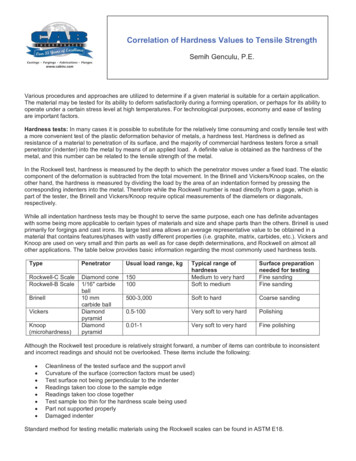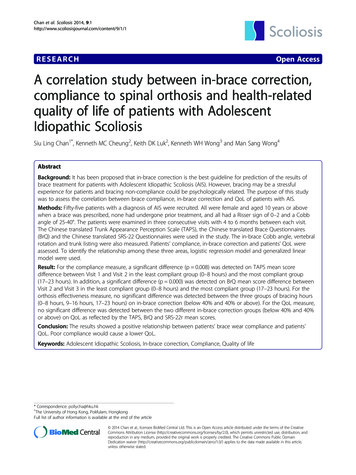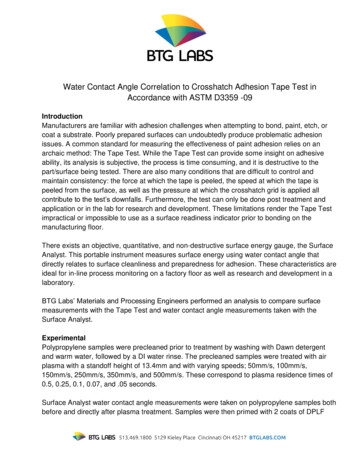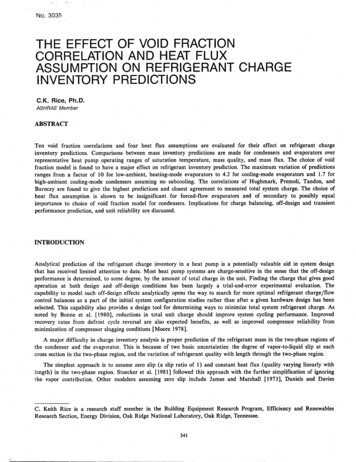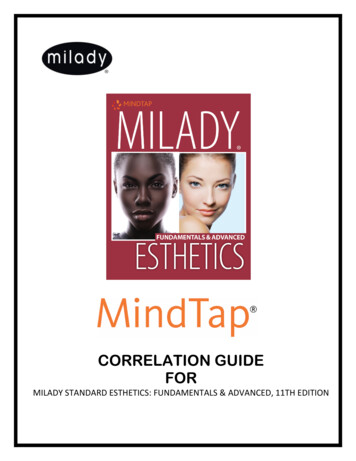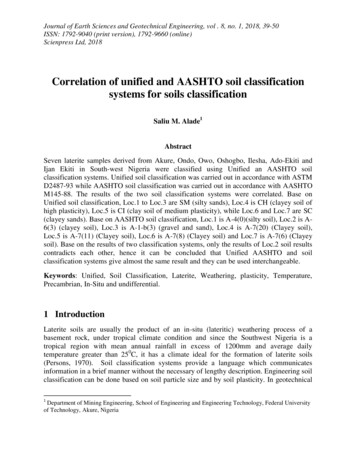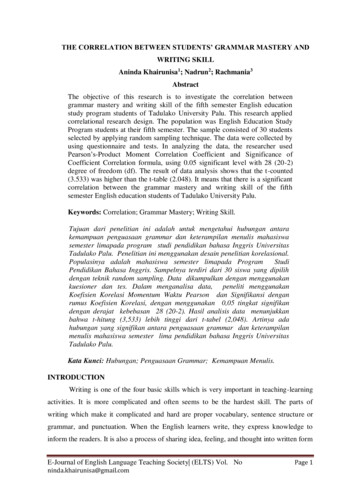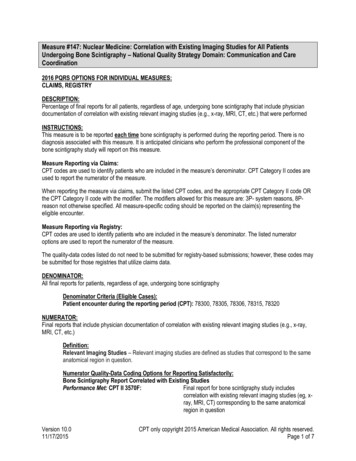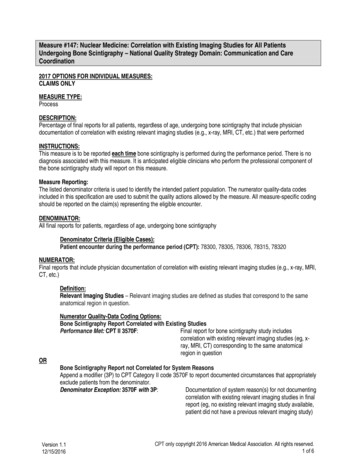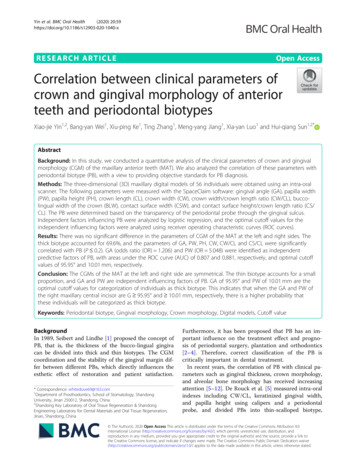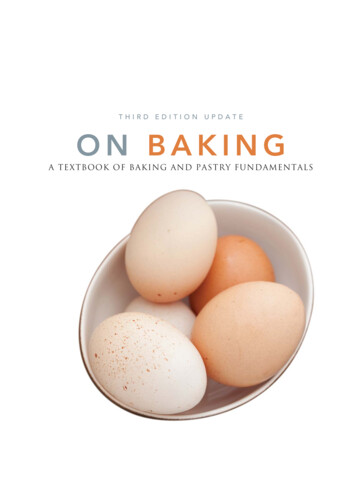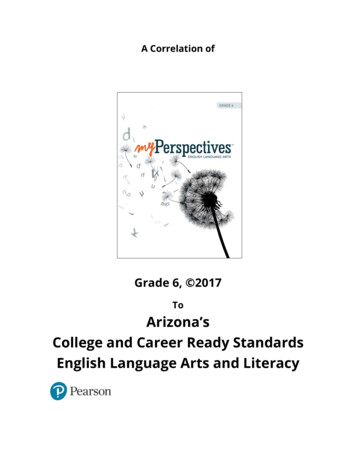
Transcription
A Correlation ofGrade 6, 2017ToArizona’sCollege and Career Ready StandardsEnglish Language Arts and Literacy
A Correlation of myPerspectives, Grade 6 2017 toArizona’s College and Career Ready Standards for English Language Arts and LiteracyGrade 6IntroductionThis document demonstrates how myPerspectives English Language Arts meets the objectives ofArizona’s College and Career Ready Standards English Language Arts and Literacy. Correlationpage references are to the Student Edition and Teacher’s Edition and are cited by selection orfeature title and page reference.myPerspectives English Language Arts is a learning environment that focuses on a connectedapproach to student learning. Students read texts and engage in activities that inspire thoughtfulconversation, discussion, and debate.Students will encounter authors’ perspectives as they read literature from across time periods andcultures. Students will listen to the perspectives of their peers through conversations andcollaborative activities. And, as students read the literature and engage in activities in myPerspectives,they will formulate—and defend—their opinions as they develop their own perspectives.In each unit of study, students will read classic and contemporary fiction and nonfiction texts, andview/listen to media selections, all related to an Essential Question. Students will use technology tointeract with texts and activities, and they can write directly in their Student Edition to makeinteraction with texts more meaningful. 2016 Pearson Education, Inc. or its affiliate(s). All rights reservedSE Student Edition2TE Teacher’s Edition
A Correlation of myPerspectives, Grade 6 2017 toArizona’s College and Career Ready Standards for English Language Arts and LiteracyGrade 6Table of ContentsReading Standards for Literature 6–8 . 4Reading Standards for Informational Text 6–8 . 6Writing Standards 6–8 . 8Speaking and Listening Standards 6–8 .14Language Standards 6–8 .16SE Student Edition3TE Teacher’s Edition
A Correlation of myPerspectives, Grade 6 2017 toArizona’s College and Career Ready Standards for English Language Arts and LiteracyGrade 6Arizona’sCollege and Career Ready StandardsEnglish Language Arts and LiteracyGrade 6myPerspectives, Grade 6 2017Reading Standards for Literature 6–8Grade 6 students:Key Ideas and Details1. Cite textual evidence to support analysis ofwhat the text says explicitly as well asinferences drawn from the text. (6.RL.1)SE/TE: “Gallery of ‘Calvin and Hobbes’ Comics,”30; “I Was a Skinny Tomboy Kid,” 74; “FeatheredFriend,” 200; Alice’s Adventures in Wonderland,368; Students will address this standard inAnalyze the Text features which appear withevery literature selection.2. Determine a theme or central idea of a textand how it is conveyed through particulardetails; provide a summary of the text distinctfrom personal opinions or judgments. (6.RL.2)SE/TE: “I Was a Skinny Tomboy Kid,” 74;“Hachiko,” 122; “Feathered Friend,” 200; “TheFun They Had,” 244; Tales From the Odyssey, 4603. Describe how a particular story’s or drama’splot unfolds in a series of episodes as well ashow the characters respond or change as theplot moves toward a resolution. (6.RL.3)SE/TE: “Hachiko,” 122; “Black Cowboy, WildHorses,” 168; The Phantom Tollbooth, Act I, 308;Alice’s Adventures in Wonderland, 368Craft and Structure4. Determine the meaning of words andphrases as they are used in a text, includingfigurative and connotative meanings; analyzethe impact of a specific word choice onmeaning and tone. (6.RL.4)SE/TE: Brown Girl Dreaming, 22; “A Blessing,”142; “Predators,” 149; “Jabberwocky,” 376, 378;Tales From the Odyssey, 4595. Analyze how a particular sentence, chapter,scene, or stanza fits into the overall structure ofa text and contributes to the development ofthe theme, setting, or plot. (6.RL.5)SE/TE: Brown Girl Dreaming, 20; “I Was a SkinnyTomboy Kid,” 74; “Hachiko,” 122; “Predators,”148; “Feathered Friend,” 200; “The Fun TheyHad,” 244; The Phantom Tollbooth, Act I, 308; ThePhantom Tollbooth, Act II, 340; Tales From theOdyssey, 4606. Explain how an author develops the point ofview of the narrator or speaker in a text.(6.RL.6)SE/TE: Brown Girl Dreaming, 20; The PhantomTollbooth, Act I, 308SE Student Edition4TE Teacher’s Edition
A Correlation of myPerspectives, Grade 6 2017 toArizona’s College and Career Ready Standards for English Language Arts and LiteracyGrade 6Arizona’sCollege and Career Ready StandardsEnglish Language Arts and LiteracyGrade 6myPerspectives, Grade 6 2017Integration of Knowledge and Ideas7. Compare and contrast the experience ofreading a story, drama, or poem to listening toor viewing an audio, video, or live version of thetext, including contrasting what they "see" and"hear" when reading the text to what theyperceive when they listen or watch. (6.RL.7)SE/TE: The Phantom Tollbooth, / The PhantomTollbooth (media), 351; Alice’s Adventures inWonderland, 371; “Jabberwocky,” 374, 3798. (Not applicable to literature) (6.RL.8)Not applicable according to Arizona’s Collegeand Career Ready Standards English LanguageArts and Literacy.9. Compare and contrast texts in differentSE/TE: Bad Boy / “I Was a Skinny Tomboy Kid,”forms or genres (e.g., stories and poems;76; Tales From the Odyssey / “To the Top ofhistorical novels and fantasy stories) in terms of Everest,” 474their approaches to similar themes and topics.(6.RL.9)Range of Reading and Level of Text Complexity10. By the end of the year, read andSE/TE: Brown Girl Dreaming, 12; “Gallery ofcomprehend literature, including stories,‘Calvin and Hobbes’ Comics,” 26; “I Was a Skinnydramas, and poems, in the grades 6–8 textTomboy Kid,” 68; First-Read Guide, Unit 1: 82,complexity band proficiently, with scaffoldingUnit 2: 176, Unit 3: 264, Unit 4: 392, Unit 5: 488;as needed at the high end of the range.Close-Read Guide, Unit 1: 83, Unit 2: 177, Unit 3:(6.RL.10)265, Unit 4: 393, Unit 5: 489; “Hachiko,” 118; “ABlessing,” 138; “Predators,” 144; “Black Cowboy,Wild Horses,” 162; “Feathered Friend,” 194; “TheFun They Had,” 238; The Phantom Tollbooth, ActI, 282; The Phantom Tollbooth, Act II, 312; ThePhantom Tollbooth (media),” 346; Alice’sAdventures in Wonderland, 362; “Jabberwocky,”372; Tales From the Odyssey, 452; Lewis & Clark,476SE Student Edition5TE Teacher’s Edition
A Correlation of myPerspectives, Grade 6 2017 toArizona’s College and Career Ready Standards for English Language Arts and LiteracyGrade 6Arizona’sCollege and Career Ready StandardsEnglish Language Arts and LiteracyGrade 6myPerspectives, Grade 6 2017Reading Standards for Informational Text 6–8Key Ideas and Details1. Cite textual evidence to support analysis ofSE/TE: Bad Boy, 66; My Life With theChimpanzees, 112; “Teens and Technology Sharewhat the text says explicitly as well asa Future,” 210; “Is Our Gain Also Our Loss?”,inferences drawn from the text. (6.RI.1)252; “The Importance of Imagination,” 384; ALong Way Home, 424; “All About Exploration,”432; Students will address this standard inAnalyze the Text features which appear withevery informational text selection.2. Determine a central idea of a text and how itis conveyed through particular details; providea summary of the text distinct from personalopinions or judgments. (6.RI.2)SE/TE: Bad Boy, 66; “The Importance ofImagination,” 384; A Long Way Home, 424; “Tothe Top of Everest,” 4723. Analyze in detail how a key individual, event,or idea is introduced, illustrated, andelaborated in a text (e.g., through examples oranecdotes). (6.RI.3)SE/TE: “Declaration of the Rights of the Child,”46; “Michaela DePrince: The War Orphan WhoBecame a Ballerina,” 57; “Is Our Gain Also OurLoss?”, 252; “The Importance of Imagination,”384; A Long Way Home, 426; “To the Top ofEverest,” 472Craft and Structure4. Determine the meaning of words andphrases as they are used in a text, includingfigurative, connotative, and technical meanings.(6.RI.4)SE/TE: “Teens and Technology Share a Future,”212; “The Black Hole of Technology,” 218, 2205. Analyze how a particular sentence,paragraph, chapter, or section fits into theoverall structure of a text and contributes tothe development of the ideas. (6.RI.5)SE/TE: Brown Girl Dreaming, 20; “Declaration ofthe Rights of the Child,” 46; “Michaela DePrince:The War Orphan Who Became a Ballerina,” 57;Bad Boy, 66; “Teens and Technology Share aFuture,” 210; “Is Our Gain Also Our Loss?”, 252;A Long Way Home, 4246. Determine an author’s point of view orpurpose in a text and explain how it isconveyed in the text. (6.RI.6)SE/TE: Brown Girl Dreaming, 20; My Life With theChimpanzees, 112; “Teens and Technology Sharea Future,” 210; “The Black Hole of Technology,”218SE Student Edition6TE Teacher’s Edition
A Correlation of myPerspectives, Grade 6 2017 toArizona’s College and Career Ready Standards for English Language Arts and LiteracyGrade 6Arizona’sCollege and Career Ready StandardsEnglish Language Arts and LiteracyGrade 6myPerspectives, Grade 6 2017Integration of Knowledge and Ideas7. Integrate information presented in differentmedia or formats (e.g., visually, quantitatively)as well as in words to develop a coherentunderstanding of a topic or issue. (6.RI.7)SE/TE: “Monkey Master,” 160; Lewis & Clark, 483Integration of Knowledge and Ideas8. Trace and evaluate the argument and specificclaims in a text, distinguishing claims that aresupported by reasons and evidence fromclaims that are not. (6.RI.8)SE/TE: “Teens and Technology Share a Future,”210; “The Black Hole of Technology,” 218;“Teens and Technology Share a Future” / “TheBlack Hole of Technology,” 222–2239. Compare and contrast one author’spresentation of events with that of another(e.g., a memoir written by and a biography onthe same person). (6.RI.9)SE/TE: Bad Boy / “I Was a Skinny Tomboy Kid,”76; “Teens and Technology Share a Future” /“The Black Hole of Technology,” 222–223Range of Reading and Level of Text Complexity10. By the end of the year, read andSE/TE: Brown Girl Dreaming, 12; “Declaration ofcomprehend literary nonfiction in the grades 6– the Rights of the Child,” 42; “Michaela DePrince:8 text complexity band proficiently, withThe War Orphan Who Became a Ballerina,” 50;scaffolding as needed at the high end of theBad Boy, 60; First-Read Guide, Unit 1: 82, Unit 2:range. (6.RI.10)176, Unit 3: 264, Unit 4: 392, Unit 5: 488; Closea. By the end of the year, read and comprehend Read Guide, Unit 1: 83, Unit 2: 177, Unit 3: 265,informational and functional text, includingUnit 4: 393, Unit 5: 489; My Life With thehistory/social studies, science, and technicalChimpanzees, 100; “Monkey Master,” 152;texts, in the grades 6–8 text complexity band“Teens and Technology Share a Future,” 206;proficiently, with scaffolding as needed at the“The Black Hole of Technology,” 214; “Thehigh end of the range. (AZ.6.RI.10)Internet of Things,” 224; “Is Our Gain Also OurLoss?”, 248; “Bored . . . and Brilliant?”, 256; “TheImportance of Imagination,” 380; A Long WayHome, 410; “All About Exploration,” 430;“Mission Twinpossible,” 444; “To the Top ofEverest,” 462SE Student Edition7TE Teacher’s Edition
A Correlation of myPerspectives, Grade 6 2017 toArizona’s College and Career Ready Standards for English Language Arts and LiteracyGrade 6Arizona’sCollege and Career Ready StandardsEnglish Language Arts and LiteracyGrade 6myPerspectives, Grade 6 2017Writing Standards 6–8Text Types and Purposes1. Write arguments to support claims with clearreasons and relevant evidence.SE/TE: “Feathered Friend,” 204; “Teens andTechnology Share a Future” / “The Black Hole ofTechnology,” 222–223; A Long Way Home, 428;Whole-Class Performance Task, Unit 3: 228–232, Unit 5: 434–438; Small-Group PerformanceTask, Unit 3: 260–261, Unit 5: 484; PerformanceBased Assessment, Unit 3: 267–268, Unit 5:491–493a. Introduce claim(s) and organize the reasonsand evidence clearly.SE/TE: “Feathered Friend,” 204; “Teens andTechnology Share a Future” / “The Black Hole ofTechnology,” 222–223; A Long Way Home, 428;Whole-Class Performance Task, Unit 3: 229,Unit 5: 435, 438; Small-Group PerformanceTask, Unit 3: 260–261; Performance-BasedAssessment, Unit 3: 267b. Support claim(s) with clear reasons andrelevant evidence, using credible sources anddemonstrating an understanding of the topic ortext.SE/TE: “Feathered Friend,” 204; “Teens andTechnology Share a Future” / “The Black Hole ofTechnology,” 222–223; A Long Way Home, 428;Whole-Class Performance Task, Unit 3: 229,232, Unit 5: 435, 438; Small-Group PerformanceTask, Unit 3: 260–261, Unit 5: 484; PerformanceBased Assessment, Unit 3: 269, Unit 5: 491c. Use words, phrases, and clauses to clarify therelationships among claim(s) and reasons.SE/TE: “Feathered Friend,” 204; “Teens andTechnology Share a Future” / “The Black Hole ofTechnology,” 222–223; A Long Way Home, 428;Whole-Class Performance Task, Unit 3: 231–232, Unit 5: 438; Performance-BasedAssessment, Unit 3: 269d. Establish and maintain a formal style.SE/TE: “Feathered Friend,” 204; “Teens andTechnology Share a Future” / “The Black Hole ofTechnology,” 222–223; A Long Way Home, 428;Whole-Class Performance Task, Unit 3: 232,Unit 5: 437; Performance-Based Assessment,Unit 3: 269SE Student Edition8TE Teacher’s Edition
A Correlation of myPerspectives, Grade 6 2017 toArizona’s College and Career Ready Standards for English Language Arts and LiteracyGrade 6Arizona’sCollege and Career Ready StandardsEnglish Language Arts and LiteracyGra
SE Student Edition TE Teacher’s Edition Introduction This . 384; A Long Way Home, 426; “To the Top of Everest,” 472 Craft and Structure 4. Determine the meaning of words and phrases as they are used in a text, including figurative, connotative, and technical meanings. (6.RI.4) SE/TE: “Teens and Technology Share a Future,” 212; “The Black Hole of Technology,” 218, 220 5 .

